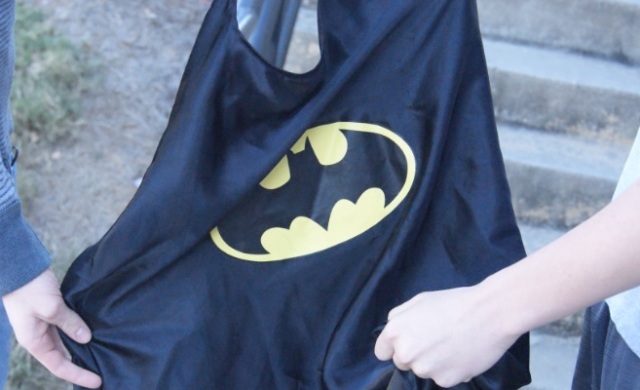A Comic of Biblical Proportions
November 6, 2014
Age is inevitable: no matter how hard people try or how hard people fight, wrinkles come, their bones get weak, and the world keeps on turning, but what about superheroes? Sure, the environments and situations may change, but the heroes themselves are rarely altered. Superman has been around for 75 years, and yet he is still a man in his mid-thirties who cannot seem to catch a break with Lois Lane, which is one of many reasons why Mark Waid’s celebrated graphic novel, Kingdom Come, is such a fascinating experience. It is an “Elseworlds” tale, or a story that isn’t canon with the current comic continuity, that explores the possible future of our favorite DC heroes as they deal with the trials of age, apathy, and Armageddon.
The story takes place several decades into the future, and things are looking pretty bleak. The heroes of the past have vanished: Superman in exile, Batman is a recluse behind a control panel, and Wonder Woman is too bitter at the world to care about it anymore. And those left to take over, their descents and heirs, fight constantly without reason other than for control over territory. At the center of this bleak story is Norman McCay, a pastor who is given visions of Armageddon through the medium of the famous book of the Bible, Revelations. With the aid of a mysterious entity known as the Specter, Norman will bear witness to a catastrophic chain of events that he may be powerless to stop.
At first glance, the plot seems like a bunch of Superhero cheese with a bit of dark material thrown in, and it could have easily fallen into that territory. There is a ton of weirdness going on, and all of it can seem rather silly, but the way it’s handled is simply brilliant. Its concept is fascinating and brings forth so many great “what-if” ideas that ultimately test the fundamental character of these famous heroes. Unlike other famous graphic novels like Watchmen or Wanted, its primary focus is not solely the weakness of these characters; it instead utilizes its somber tone and challenging themes to both deconstruct and celebrate these heroes. The story of Revelations is a prominent symbol throughout the novel, as the narration and the artwork continue to allude to the scriptures, but they never feel forced. Instead, the allusions help to move the story along and serve as a guide for our protagonist to reference. Although, those allusions can annoy readers who are not familiar with the Bible or the story of Revelations, as they are brought up so often in the novel, it would certainly be a major problem for them. The dialogue is engaging and realistic. Conversations and responses feel natural, and the writing tries to stray from anything too-grandiose or corny…at least until around the final chapters. The pacing is done well, never feeling tedious or rushed. However, the novel is not action oriented. While there are spectacular battles, they take a backseat to the thoughts and feelings of the characters as they struggle with such difficult themes such as the issue of how far people can and should go with power, when people have to turn responsibility over to others, and the importance of the legacy they leave behind.
Another one of the novel’s strengths is its respect to the characters and their personalities. Each of the familiar characters talk and act like they should, but with some changes to make their transition smooth into the modern setting of this story. Take, for instance, Superman in this story: Superman, as modern culture has come to know him, is the quintessential hero, a man defined by his moral integrity. He never lies, never cheats, and never, ever kills, no matter how horrible the situation. Throughout the novel, he is chastised for having a “too idealistic” and “ineffective” way of thinking, and is constantly pressured to either adapt to more “effective” methods such as actually killing his enemies, or simply step down from his position. Superman, the big blue Boy Scout he is, remains steadfast to his morals despite the relentless pressure; however, he still starts to question his moral mindset as well as his faith in the world, as he finds problems steadily mounting over him. The story also does manage to give some of its new characters distinguished personalities as well, but these new characters, with the exception of the protagonist, are mainly peripheral eye-candy.
One of the most important aspects of a graphic novel is its art. Done by Alex Ross, the images are nothing short of beautiful. Not only is every page painted in such realistic detail, but they also yield a classic style. It calls to mind the old painted Coca-Cola ads from the 50’s, and in a story where the ideals of the past are struggling to work with the cynicism of the future, it is a perfect fit. Having the structure of our modern world under retro lens is a nigh-surreal experience, just as it is for past readers and fans to see this fantastic world in the state that it is. Readers cannot help but be impressed by how utterly packed with visuals some of these panels can be. I mentioned earlier there are plenty of peripheral side-characters that mainly serve just as eye-candy. What wasn’t mentioned, however, is just how amazingly detailed that peripheral eye-candy is. Thousands of characters clutter the pages, and yet the artist took his time with each and every one, right down to the wrinkles in their costumes. That detail helps make the characters look very distinct, and even when a panel is littered with people a reader could easily distinguish one from another.
Unfortunately, even good books have their issues. One of the most prominent problems with the story is the fact that it seems solely geared to the die-hard fans. The book relies a lot on its back-story heavy setting, and anyone who is not really familiar would get lost very easily. Another issue is that the art starts to become a little too realistic, to the point where it can become creepy. As I mentioned previously the Biblical references can leave those of other religions feeling uncomfortable. Another potential problem is that the story itself definitely has a decisive feeling for its themes. It is understandable that some people would have rather had the writer leave the resolution a little more ambiguous, as the themes that are prominent cover morally-gray territory.
On the whole, this is a fantastic graphic novel. It has an engaging story, faithful characters, thought-provoking themes, and enough references to make any comic fan happy. However, the book does have a limited audience, with it being geared to a more die-hard comic fan-base and with it being so intertwined with biblical references. If these problems are not bothersome, then this book is most certainly worth the buy.




